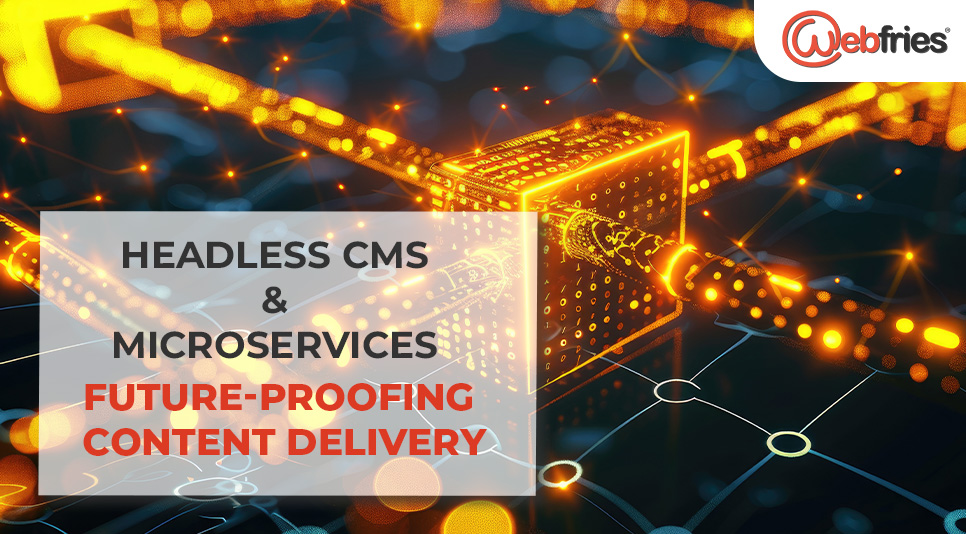As a leading provider of website design in Gurgaon, Webfries constantly explores cutting-edge technologies that reshape how content is delivered. The shift towards headless CMS and microservices architecture represents more than just a trend – it’s a fundamental transformation in how businesses approach website development in Gurgaon and beyond.
The Evolution from Traditional to Headless CMS
Traditional content management systems have served businesses well for decades, but the modern digital landscape demands more flexibility. Headless CMS architecture separates the content repository (backend) from the presentation layer (frontend), enabling unprecedented flexibility in content delivery across multiple channels.
This decoupled approach is particularly crucial for businesses requiring sophisticated website development in Gurgaon, where companies need to deliver content across websites, mobile applications, IoT devices, and emerging digital touchpoints simultaneously.
The Rise of API-First Platforms: Strapi 5 Leading the Charge
Strapi 5 exemplifies the new generation of API-first CMS platforms designed for the microservices era. Unlike traditional CMS solutions that bundle everything together, Strapi provides:
Developer-Centric Features
- ▪RESTful and GraphQL APIs: Enabling developers to query content efficiently
- ▪Customizable API endpoints: Tailoring data delivery to specific application needs
- ▪Plugin architecture: Extending functionality without bloating the core system
- ▪TypeScript support: Ensuring type safety and better development experience
Content Team Benefits
- ▪Intuitive interface: Making content management accessible to non-technical users.
- ▪Dynamic content modeling: Creating flexible content structures on the fly
- ▪
- ▪Multi-language support: Managing content across different languages seamlessly
- ▪Role-based permissions: Ensuring secure content management workflows
Omnichannel Content Distribution: Meeting Customers Everywhere
The modern consumer interacts with brands across multiple touchpoints. A headless approach enables true omnichannel content distribution, ensuring consistent messaging whether customers engage through:
1. Traditional website
2. Mobile applications
3. Voice assistants
4. Smart displays
5. Wearable devices
6. Digital kiosks
For companies investing in website design in Gurgaon, this flexibility means content created once can be distributed everywhere, maximizing ROI and ensuring brand consistency.
Hybrid CMS Models: Balancing Flexibility with Familiarity
While pure headless systems offer maximum flexibility, hybrid CMS models bridge the gap between traditional and headless approaches. These solutions provide:
Visual Content Editing
Hybrid systems maintain WYSIWYG editors for marketers who prefer visual content creation, while still offering API-first delivery for developers.
Template Management
Pre-built templates accelerate development while maintaining the flexibility to create custom frontend experiences.
Progressive Decoupling
Organizations can migrate gradually, starting with specific sections or channels before fully embracing headless architecture.
Security Advantages of Microservices Architecture
Security remains paramount in modern website development in Gurgaon projects. Microservices architecture enhances security through:
Reduced Attack Surface
By separating frontend and backend systems, potential vulnerabilities in one layer don’t compromise the entire system.
Isolated Components
Individual services can be updated or patched without affecting the entire system, reducing downtime and security risks.
Granular Access Control
API-based systems enable fine-grained permissions, ensuring users only access necessary resources..
Enhanced Monitoring
Microservices enable detailed monitoring of individual components, making it easier to detect and respond to security threats.
IoT Integration: Preparing for the Connected Future
The Internet of Things (IoT) ecosystem demands content delivery systems that can communicate with diverse devices. Headless CMS platforms excel in this environment by:
Device-Agnostic Content Delivery
APIs can serve content to any device capable of making HTTP requests, from smart refrigerators to industrial sensors.
Edge Computing Compatibility
Content can be cached and served from edge locations, reducing latency for IoT applications.
Real-Time Data Synchronization
Websocket support enables real-time content updates across connected devices.
Edge Computing Compatibility
Content can be cached and served from edge locations, reducing latency for IoT applications.
Implementation Considerations for Businesses
When transitioning to headless CMS and microservices architecture, consider:
Technical Requirements
- ▪Development team expertise in API consumption
- ▪Infrastructure for managing distributed systems
- ▪Monitoring and logging capabilities
- ▪ CDN integration for optimal performance
Content Strategy Adaptation
- ▪Structured content modeling
- ▪Channel-specific content variations
- ▪Workflow adjustments for decoupled publishing
- ▪Analytics integration across channels
Cost-Benefit Analysis
- ▪Initial development investment
- ▪Long-term maintenance savings
- ▪Scalability benefits
- ▪Time-to-market improvements
Future Trends Shaping Content Delivery
As we look ahead, several trends will continue to influence headless CMS adoption:
AI-Powered Content Management
Integration with AI tools for content generation, optimization, and personalization.
Edge Computing
Processing content closer to end-users for improved performance and reduced latency.
Composable Architecture
Building digital experiences by combining best-of-breed services rather than monolithic solutions.
Blockchain Integration
Ensuring content authenticity and managing digital rights through distributed ledger technology.
Making the Right Choice for Your Business
Selecting between traditional, headless, or hybrid CMS solutions depends on:
- ▪Technical capabilities: Your team’s expertise and resources
- ▪Business requirements: Content complexity and distribution needs
- ▪Growth projections: Scalability requirements and future channels
- ▪Budget constraints: Initial investment versus long-term benefits
Conclusion
The shift to headless CMS and microservices architecture represents a fundamental change in how businesses approach content delivery. For companies seeking modern website design in Gurgaon, understanding and implementing these technologies is crucial for staying competitive.
As digital experiences continue to evolve, the flexibility and scalability offered by headless solutions become increasingly valuable. Whether through pure headless systems like Strapi 5 or hybrid approaches, the future of content delivery lies in API-first, microservices-based architectures that can adapt to whatever new channels and devices emerge.
The key is not just adopting new technology for its own sake, but strategically implementing solutions that align with your business goals and prepare you for future digital challenges. With the right approach, headless CMS and microservices can transform how you deliver content, engage customers, and drive business growth in an increasingly connected world.



